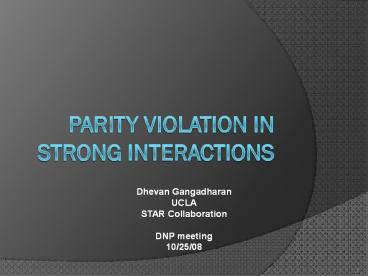Parity Violation in Strong Interactions - PowerPoint PPT Presentation
Title:
Parity Violation in Strong Interactions
Description:
Wu. et al. Physical Review 105(4), 1957. Garwin. et al. ... This trend is in accord with theory since should be of opposite sign than. 10. STAR Preliminary ... – PowerPoint PPT presentation
Number of Views:51
Avg rating:3.0/5.0
Title: Parity Violation in Strong Interactions
1
Parity Violation in Strong Interactions
Dhevan Gangadharan UCLA STAR Collaboration DNP
meeting 10/25/08
2
Outline
- Examples of Weak Parity Violation
- The Theory of Parity Violation in the strong
interactions - The STAR experimental result
- Outlook/Conclusions
3
Examples of Weak Parity Violation
Beta decay of Co-60
In flight Pion decay
Electrons are preferentially emitted opposite the
spin of the nucleus
Muons are preferentially polarized along the
direction of the Pions motion
e-
e-
S
Wu. et al. Physical Review 105(4), 1957
Garwin. et al. Physical Review, 105(4), 1957
4
Spontaneous Parity Violation in Strong
Interactions
This can occur through The Chiral Magnetic
Effect
Kharzeev et al. arXiv 0808.3382
- The Chiral Magnetic Effect
- Ingredient 1of 2
- The Vacuum Structure undergoes a Transition
Sphaleron
5
- The Chiral Magnetic Effect
- Ingredient 2 of 2
- A Non-zero background Magnetic field
Spectator nucleons create a Magnetic Field
6
- The Chiral Magnetic Effect
- As a consequence
- An Electric Field parallel to the Magnetic Field
is created
7
- The Chiral Magnetic Effect
- The End Result
- The Electric Field will cause charge separation
relative to the reaction plane
- Charge separation represents an E-M current
perpendicular to the reaction plane
For a given topological charge the E-M current
direction has a preference. This is Parity
Violation
8
Looking for Charge Separation
- Transitions to -1 Topological charge are just as
likely. - 1 and -1 states yield opposite E-M currents.
- Charge separation is given by a ? 0 in
- However, will vanish
when averaged over many events because of the
equal presence of 1 and -1 states. - Thus, one must use correlation techniques
S. A. Voloshin, Phys. Rev. C 70, 057901 (2004)
9
The STAR detector at RHIC
Tracking of particles is done by the TPC (light
grey region) AuAu 200 GeV collisions used for
this analysis.
10
STAR Preliminary
More plots of this correlator with different
systems and against different variables can be
found at arXiv0806.0029
- Opposite charge combinations show a distinctly
different trend than same charge combinations. - This trend is in accord with theory since
should be of opposite sign than
11
Next..
- Rule out non-P violating contributions to our
observable (Our correlator is a P-even quantity)
- Reconstructed particles (?, ?) can be used to
replace particle a in - to determine whether the same asymmetry persists.
This is interesting since in principle the
electric field generated can affect all three
constituent quarks before they coalesce. A ?
contains 3 negative quarks whereas a ? contains a
mixture of positive and negative quarks.
?bar
?
12
Conclusions
- Heavy-Ion collisions might create Spontaneous
Parity violating processes in Strong
Interactions. - The gross quantitative and qualitative features
of the correlation used in this analysis are in
accord with theoretical expectations.































